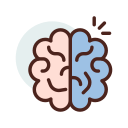
Skripsi
KLASIFIKASI PENYAKIT STROKE MENGGUNAKAN METODE NAIVE BAYES DAN FUZZY NAIVE BAYES BERDASARKAN RESAMPLING REPEATED SPLIT VALIDATION
Penilaian
0,0
dari 5
A stroke is a nerve funcion that results from a blockage caused by blood clots and causes the oxygen and nutrients in the brain to suffer tissue damage. This study uses the Naïve Bayes and Fuzzy Naïve Bayes method based on Repeated Split Validation Resampling and variable selection use Chi square to classify stroke disease. The data used on this research is a Stroke Prediction Dataset from Kaggle’s website. Classification of stroke disease using Naïve Bayes obtained an average Accuracy of 92,27%, Precision of 96,09%, Recall of 95.79%, and FScore of 95,94%, where here as using the naïve bayes method with chi square obtained an average Accuracy of 92,66%, Precision of 96,50%, Recall of 95.81%, and FScore of 96,16%. Classificatiion of stroke disease using Fuzzy Naïve Bayes obtained an average Accuracy of 93,15%, Precision of 97,43%, Recall of 95.46%, and FScore of 96,44%, where as using Fuzzy Naïve Bayes method with chi square obtained an average Accuracy of 93,54%, Precision of 97,74%, Recall of 95,57%, and FScore of 96,64%. Based on factors that contribute to the prediction of stroke and calculations using the Naïve Bayes and Fuzzy Naïve Bayes methods, the results are 95% not a stroke and 5% of a stroke.
Availability
| Inventory Code | Barcode | Call Number | Location | Status |
|---|---|---|---|---|
| 2407000018 | T131704 | T1317042024 | Central Library (References) | Available but not for loan - Not for Loan |
Detail Information
- Series Title
-
-
- Call Number
-
T1317042024
- Publisher
- Indralaya : Prodi Ilmu Farmasi, Fakultas Matematika dan Ilmu Pengetahuan Alam., 2023
- Collation
-
xv, 75 hlm.; ilus.; 29 cm
- Language
-
Indonesia
- ISBN/ISSN
-
-
- Classification
-
615.107
- Content Type
-
Text
- Media Type
-
unmediated
- Carrier Type
-
-
- Edition
-
-
- Subject(s)
- Specific Detail Info
-
-
- Statement of Responsibility
-
KA
Other version/related
No other version available
File Attachment
Comments
You must be logged in to post a comment
 Computer Science, Information & General Works
Computer Science, Information & General Works  Philosophy & Psychology
Philosophy & Psychology  Religion
Religion  Social Sciences
Social Sciences  Language
Language  Pure Science
Pure Science  Applied Sciences
Applied Sciences  Art & Recreation
Art & Recreation  Literature
Literature  History & Geography
History & Geography